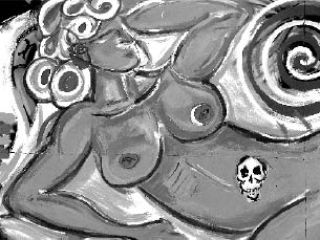“I guess you could say that the naked bodies began when I moved to Lopez.” Laughing, artist Emily Metcalf is discussing what is undoubtedly her most famous painting, a mural that appeared last year in Lopez Village and which showed a woman ‘attired’ in what one might call a suit of the Emperor’s new clothes.
Like her work, Metcalf’s answer to the question of how Lopez has influenced her painting is witty, honest, and unconventional. This response is her way of illustrating that her paintings were much darker, much more disconcerting before she came here five years ago to live full time. Today, Metcalf regards her work as “expressive, daring, and colorful” and says she’s now “less of a disturbed artist.”
Metcalf, who began painting in her junior year at The Northwest School in Seattle, credits the environment there, as well as the time she spent at the Pratt Institute, with developing in her a love of the arts. Along with the early inspiration of her education, she is both voluble and definite about other influences on her work.
In addition to Kadinsky, Matisse, Gauguin, and Picasso, Metcalf credits Van Gogh and the Fauves for their powerful and liberating sense of color. “What Van Gogh did for me is really simple: I can paint the tree purple and orange even though there’s no purple and orange in the tree. It’s an abstract way to color which allows me to bring my interpretation, my vision, into the tree.”
With this statement, Metcalf defines what she’s trying to accomplish with her paintings, encapsulating her goal in a single phrase, “self-expression.” Her work, she says, is “about the process of creating and about my inner world. It represents a kind of journaling piece; it’s about me managing my emotions. Art keeps me in the moment.”
Explaining that she’s a poet as well as a painter, Metcalf continues. “I once did a series of paintings on words. I would choose a word such as ‘patience’ or ‘freedom,’ then paint what that word evoked in me. It was a way to organize my thoughts, often a way to save me from a horrible moment.”
Here, Metcalf pauses, then says that it’s important for people to know that she is bipolar, a fact that in many ways is central to her entire philosophy of art. “Mental illness has been a huge part of my journey. I want people out there who might be suffering as I have to know that there is such healing in the creative process. If I really need to say something, I can do it in paint even though I’m dumbfounded as far as the words are concerned. I can talk about what’s going on with me in pictures and that’s so important.”
Another part of her journey toward healing has been her writing, including a memoir she wrote in her early twenties titled Besieged in the Looking Glass. Both her writing and painting have enabled Metcalf to become “unstuck from certain facts that have held me back, to transcend these facts, and to move on in my life.”
Metcalf, like the artist Kadinsky, about whom she has studied and written, is also deeply involved in music, writing and performing for children. She has just completed a monthly show at Grace Episcopal Church and will be doing a series of shows for children at the Lopez Island Library. “Working with children is the other half of my life,” she says.
She has studied piano, guitar, violin, and Ashiko drums, and says that she sings “all the time, to the children, to the dog, just to hear myself singing.”
When asked in what direction she would like to see her art heading, Metcalf says without hesitation that she intends to return to working with oils and wants to paint more large pieces.
Metcalf has begun to take commissions and may be reached at 468-2777 or emilymetcalf@interisland.net.
Artist Emily Metcalf is as direct and honest as her laughter, her opinions, her “famous” mural, all of which demonstrate the obvious joy with which she faces and lives her life.



